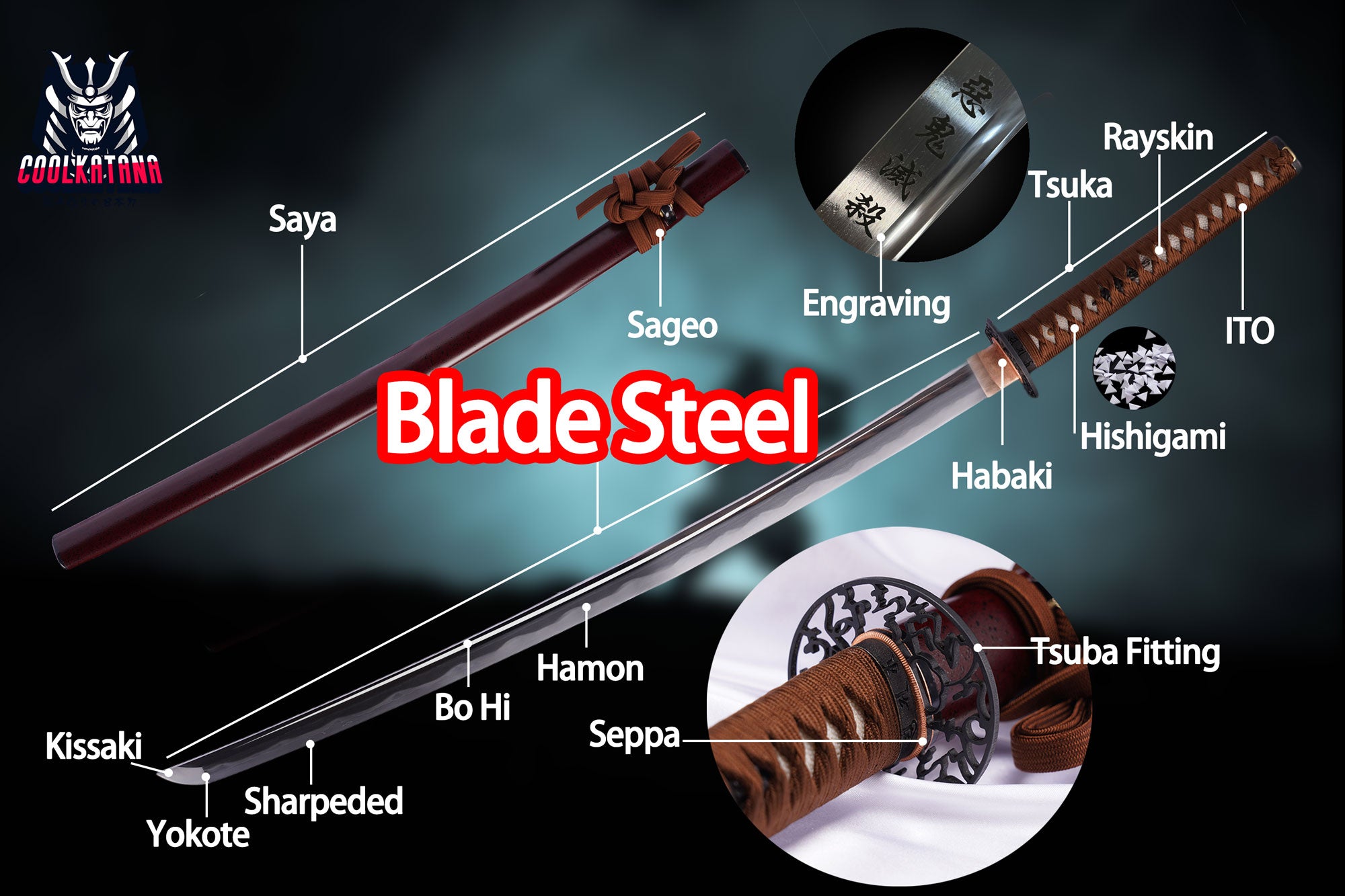In-depth analysis of samurai sword steels and their unique advantages

Deep Analysis of Blade Steel Types and Advantages in Samurai Swords
The katana, or samurai sword, is not only a symbol of Japanese culture but also a shining jewel in the history of cold weapons. Its remarkable cutting ability, exquisite craftsmanship, and profound cultural heritage have made it a coveted item for collectors and weapon enthusiasts around the world. Legend has it that the sharpness of a katana is such that it can slice through an enemy’s spear with a single strike, instantly cutting through every vein in the body. These miraculous cutting abilities are largely attributed to the high-quality steel used in the blade.
In ancient Japan, the process of forging a katana was extremely intricate, with the selection and sharpening of the blade steel being of paramount importance. The steel used in crafting samurai swords needed to possess good hardness, toughness, sharpness, and strong corrosion resistance. Over centuries, Japanese swordsmiths have perfected the art of exploiting the advantages of various types of steel. For instance, the legendary swordsmith Muramasa, known for his “Muramasa Swords,” created blades from steel so outstanding that they became synonymous with the finest samurai swords.
Today, while the ancient techniques of katana forging are still passed down, modern swordsmiths have introduced new types of steel and treatment methods to further enhance the performance of samurai swords. Below, we delve into some common types of steel used in the production of samurai swords, such as T10 high-carbon steel, 1095 high-carbon steel, Damascus steel, high-manganese steel, and folded steel. Each steel type has its unique characteristics and advantages, making it suitable for different types of samurai swords.
What Steel is Used for Blades?
When it comes to crafting samurai swords, the choice of steel is crucial to the performance of the blade. The steel used for katana blades must ensure sharpness, durability, and toughness. Over centuries, swordsmiths have carefully selected and utilized the unique properties of various steels to create blades that are sharp, strong, and long-lasting. Below are some common steels used in the crafting of samurai swords:
1. T10 High Carbon Steel: A Classic Choice for Sharpness and Durability
T10 high-carbon steel is known for its exceptional hardness and wear resistance, making it a highly favored choice in blade-making. With a carbon content ranging from 0.95% to 1.05%, it achieves a hardness of 58-60HRC after proper heat treatment, providing superior sharpness and longevity. The T10 steel blade maintains its sharpness for a long time, offering strong cutting power, especially in tasks requiring precision and sharp edges. Traditional Japanese swordsmiths commonly use this steel in blade-making, and its excellent wear resistance ensures that the blade remains effective even after prolonged use.
Advantages of T10 High Carbon Steel:
- High Hardness and Long-Lasting Sharpness: T10 steel maintains a sharp edge for an extended period, suitable for various cutting tasks.
- Excellent Wear Resistance: Even with prolonged use, the T10 steel blade remains sharp and maintains high cutting efficiency.
- Versatile Applications: T10 steel performs excellently in both everyday and high-intensity tasks.
Not only has T10 steel been widely used in traditional swordsmithing, but it has also become a reliable material for modern katana production, offering high cost-performance and excellent overall performance.

2. 1095 High Carbon Steel: A Traditional Steel with a Perfect Balance of Price and Performance
1095 high-carbon steel has been a staple in blade manufacturing due to its moderate hardness and exceptional cutting performance. With a carbon content of 0.90% to 1.03%, 1095 steel offers a good balance of sharpness, elasticity, and wear resistance. It is relatively easy to forge, making it one of the key materials for traditional katana blades. Historically, 1095 steel was widely used in the production of knives and swords during World War II, particularly by the U.S. military, and it continues to be celebrated for its affordability and impressive cutting ability.
Advantages of 1095 High Carbon Steel:
- Excellent Cutting Power and Sharpness: After precise heat treatment, 1095 steel provides an extremely sharp edge, perfect for fine cutting tasks.
- High Cost-Effectiveness: Compared to other premium steels, 1095 steel offers great value for money, making it an attractive option for users seeking good performance at a lower price.
- Ease of Processing and Forging: Due to its simpler chemical composition, 1095 steel is easy for swordsmiths to forge into the desired shape.
1095 steel is widely used in the production of various blades, particularly for those seeking daily-use or collectible samurai swords. Its hardness and sharpness make it a classic choice among blade enthusiasts.

3. Damascus Steel: The Perfect Fusion of Art and Function
Damascus steel is an ancient steel known for its distinctive folding process and beautiful patterns. The technique involves folding different types of steel repeatedly, which results in a layered structure within the steel. This not only enhances the blade's strength and sharpness but also creates visually stunning patterns, known as "water patterns" or "flower patterns," which are aesthetically valued in addition to their strength. Damascus steel blades typically exhibit exceptional toughness and cutting power.
Advantages of Damascus Steel:
- Outstanding Overall Performance: The balance of hardness and toughness makes Damascus steel blades both sharp and durable, ideal for long-term use.
- Unique Patterns and Aesthetic Value: Each Damascus steel blade is one-of-a-kind, with beautiful patterns that add artistic value to the blade.
- Excellent Cutting Performance: The structure and forging technique of Damascus steel ensure that the blade remains razor-sharp and capable of cutting through various materials effortlessly.
Damascus steel blades often represent high-end blades, embodying both craftsmanship and artistic value. Many modern katana makers use this steel to showcase their mastery, and Damascus steel blades are highly sought after by collectors and art lovers.

4. High Manganese Steel: The Best Choice for Impact Resistance and Durability
High-manganese steel, which contains a high proportion of manganese, is highly valued for its exceptional impact resistance and toughness. This steel can withstand significant impact forces and wear, making it suitable for blades that need to endure extreme conditions. While the hardness of high-manganese steel may be somewhat lower compared to other steels, its superior toughness and durability make it ideal for high-stress applications, particularly in combat situations.
Advantages of High Manganese Steel:
- Exceptional Impact Resistance: High-manganese steel can withstand massive impact forces, making it ideal for use in battle or harsh environments.
- Outstanding Wear Resistance: The blade resists wear and tear, maintaining good performance even after prolonged use.
- Exceptional Durability: High-manganese steel maintains its integrity under heavy stress and use, making it a perfect choice for tough, high-demand environments.
High-manganese steel is often used in blades designed for extreme durability and impact resistance, making it ideal for military, survival, and combat situations.

5. Folded Steel: A Fusion of Historical Craftsmanship and Modern Technology
Folded steel, particularly traditional "Japanese steel" (such as white steel, blue steel, etc.), is created by repeatedly folding and forging the steel to form dense, layered structures. This process not only increases the hardness and toughness of the steel but also improves its corrosion resistance. The surface of folded steel often exhibits beautiful, wave-like patterns, giving each blade a unique artistic quality. Moreover, folded steel offers excellent overall performance, maintaining sharpness even under intense usage.
Advantages of Folded Steel:
- Balance of Hardness and Toughness: The folding process creates an ideal balance between hardness and toughness, allowing the blade to withstand prolonged, intense use.
- Unique Aesthetic Value: The wave-like patterns formed during the folding process make each blade a work of art.
- High Strength and Impact Resistance: The multi-layered structure of folded steel ensures exceptional resistance to impact and stress, preventing the blade from breaking or dulling easily.
Folded steel represents the pinnacle of traditional craftsmanship, and it is still a popular choice for high-end katana production. It combines functionality with beauty, making it a prized material among collectors and weapon enthusiasts.

www.coolkatana.com

Conclusion
Each type of steel offers its unique advantages and applications, from the sharpness and durability of T10 high-carbon steel to the beautiful artistry and functionality of Damascus steel, and from the high impact resistance of high-manganese steel to the rich heritage and versatility of folded steel. These steels ensure that every katana achieves a perfect balance of performance and aesthetic value. For katana enthusiasts, understanding the advantages of each steel type not only helps in choosing the right blade but also deepens their appreciation for the history and cultural significance embedded in these magnificent weapons.
